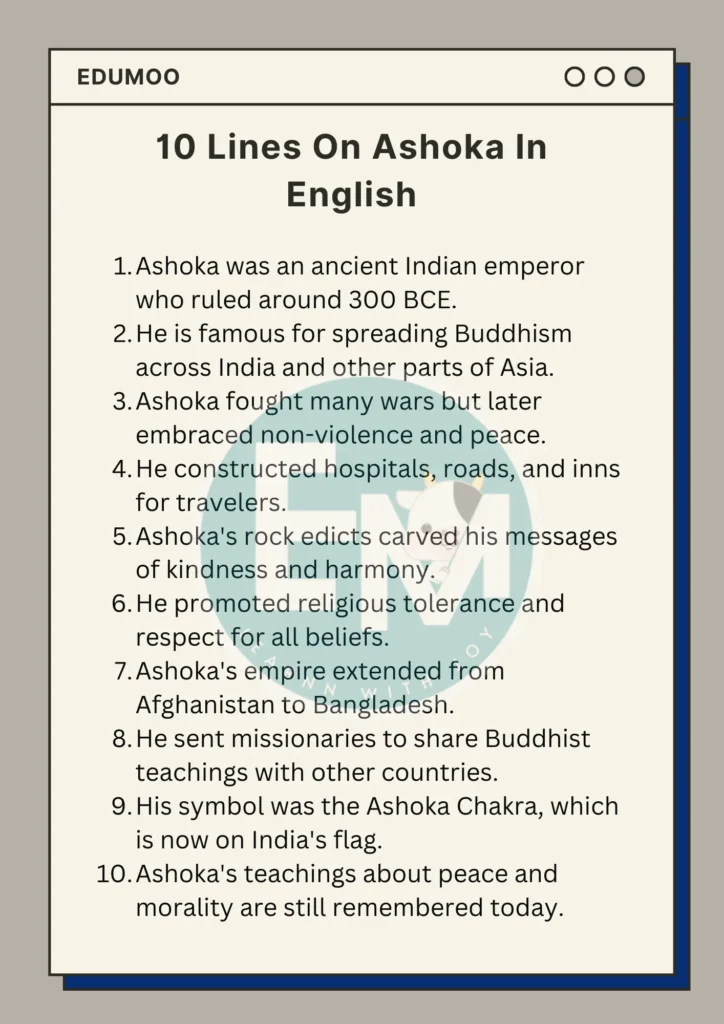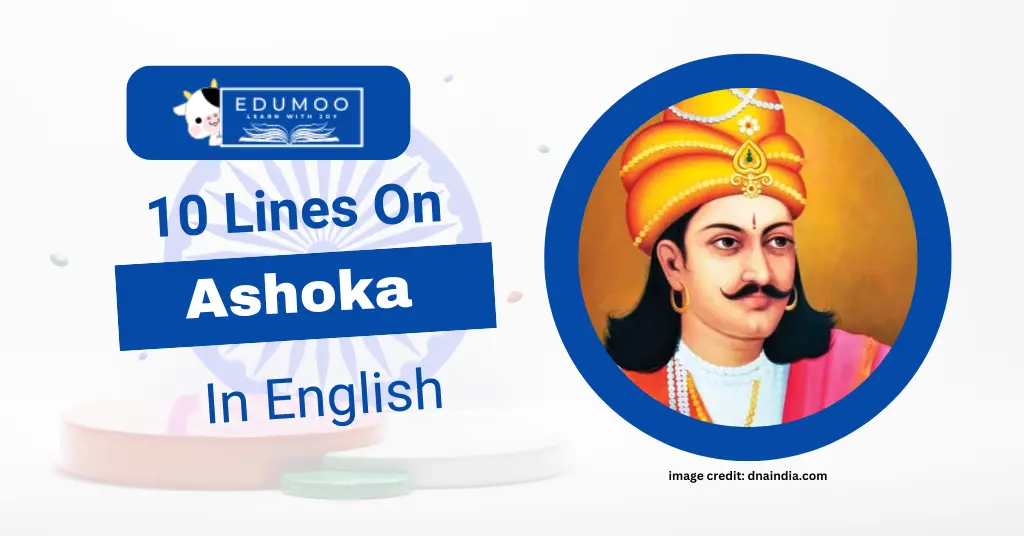Ashoka, an ancient Indian emperor, is celebrated for his contributions to peace and Buddhism. His reign marks a pivotal moment in history when he transformed from a conqueror to a proponent of non-violence and compassion. This blog explores ten lines on Ashoka, focusing on his achievements and how he shaped ancient India and beyond.
10 Lines On Ashoka In English
- Ashoka was an ancient Indian emperor who ruled around 300 BCE.
- He is famous for spreading Buddhism across India and other parts of Asia.
- Ashoka fought many wars but later embraced non-violence and peace.
- He constructed hospitals, roads, and inns for travelers.
- Ashoka’s rock edicts carved his messages of kindness and harmony.
- He promoted religious tolerance and respect for all beliefs.
- Ashoka’s empire extended from Afghanistan to Bangladesh.
- He sent missionaries to share Buddhist teachings with other countries.
- His symbol was the Ashoka Chakra, which is now on India’s flag.
- Ashoka’s teachings about peace and morality are still remembered today.

Essay On Ashoka In English In 350 Words
Ashoka was one of the most important rulers in ancient India. He ruled the Maurya Empire from around 268 BCE to 232 BCE. At the beginning of his reign, Ashoka was a powerful and ambitious king who sought to expand his empire through wars and conquests. One of the most famous battles he fought was the Kalinga War. This war caused massive destruction and loss of life, which deeply affected Ashoka.
After the Kalinga War, Ashoka experienced a profound transformation. He was horrified by the suffering and death caused by the war and decided to change his ways. Ashoka embraced Buddhism, a religion that teaches peace, non-violence, and compassion. He decided to rule his empire based on these principles, promoting welfare and harmony among his people.
Ashoka’s commitment to Buddhism led him to spread its teachings far and wide. He sent missionaries to various parts of Asia, including Sri Lanka, Nepal, and even as far as Greece and Egypt. These missionaries helped spread the message of peace and compassion across the world.
To communicate his new values, Ashoka created a series of edicts, which were inscribed on rocks and pillars throughout his empire. These edicts, known as the Rock and Pillar Edicts, shared his messages about kindness, tolerance, and respect for all living beings. They also emphasized the importance of moral behavior, justice, and helping those in need.
Ashoka also undertook various public works to improve the lives of his subjects. He built hospitals, roads, rest houses, and wells to ensure the welfare of his people. Ashoka’s efforts to promote social welfare and his dedication to non-violence made him a beloved and respected ruler.
One of Ashoka’s most enduring symbols is the Ashoka Chakra, a wheel with 24 spokes representing the principles of dharma (righteousness). This symbol is now featured on the Indian national flag, reminding us of Ashoka’s legacy.
Ashoka’s reign is remembered as a golden age of peace and prosperity. His commitment to Buddhism and his efforts to create a just and compassionate society continue to inspire people around the world. Ashoka’s story teaches us the power of change, the importance of compassion, and the impact of leading with kindness and justice.
| Also Read: Sanchi Stupa 10 Lines |
Essay On Ashoka In English In 750 Words
Ashoka was one of the most remarkable and influential rulers in Indian history. He was the third emperor of the Maurya Dynasty, ruling from around 268 BCE to 232 BCE. Ashoka is best known for his transformation from a fierce warrior to a benevolent and compassionate ruler who embraced Buddhism and spread its teachings across Asia.
Ashoka was born into the powerful Maurya dynasty
When Bindusara died, there was a struggle for the throne. Ashoka emerged victorious and became the emperor. At the beginning of his reign, Ashoka was an ambitious and ruthless leader. He sought to expand his empire and engaged in several military campaigns. The most famous of these was the Kalinga War.
The Kalinga War was a turning point in Ashoka’s life. Kalinga was a prosperous and strategically important region located on the east coast of India. Ashoka wanted to conquer it to further strengthen his empire. The war was fierce and brutal, resulting in massive loss of life and widespread destruction. According to historical records, over 100,000 soldiers and civilians were killed, and many more were wounded or displaced.
The aftermath of the war had a profound impact on Ashoka. He was deeply moved by the suffering and devastation he had caused. Filled with remorse and sorrow, Ashoka began to question the value of his conquests and the pain they brought to people. This introspection led him to seek a new path, one that embraced peace and compassion.
Ashoka’s search for inner peace and a new way of life led him to Buddhism, a religion founded by Siddhartha Gautama (Buddha) that emphasized non-violence, compassion, and the pursuit of enlightenment. Ashoka embraced Buddhism wholeheartedly and decided to rule his empire based on its principles.
He became a devout follower of Buddha’s teachings and actively promoted Buddhism throughout his empire. Ashoka’s conversion to Buddhism marked the beginning of a new era in his reign. He gave up violence and chose to follow a path of peace and kindness to all living beings.
One of Ashoka’s most significant contributions was his effort to spread the message of Buddhism far and wide. He sent missionaries to various parts of Asia, including Sri Lanka, Nepal, Afghanistan, and even as far as Greece and Egypt. These missionaries played a crucial role in spreading Buddhist teachings and establishing Buddhist communities in these regions.
To communicate his new values and policies, Ashoka issued a series of edicts, which were inscribed on rocks and pillars throughout his empire. These edicts, known as the Rock and Pillar Edicts, conveyed messages about kindness, tolerance, and respect for all living beings. They also emphasized the importance of moral behavior, justice, and the welfare of his subjects.
Ashoka’s commitment to the welfare of his people was evident in the numerous public works he undertook. He built hospitals for humans and animals, constructed roads and rest houses for travelers, and dug wells to provide clean drinking water. Ashoka also planted trees along roadsides to provide shade and fruit to travelers.
He established veterinary clinics and encouraged the humane treatment of animals. Ashoka’s efforts to promote social welfare and improve the lives of his subjects earned him the love and respect of his people.
One of the most enduring symbols of Ashoka’s legacy is the Ashoka Chakra, a wheel with 24 spokes representing the principles of dharma (righteousness). This symbol can be found on many of Ashoka’s edicts and is now a central part of the Indian national flag. The Ashoka Chakra serves as a reminder of Ashoka’s commitment to justice, morality, and the welfare of all beings.
Ashoka’s reign is often considered a golden age of Indian history. His policies of non-violence, religious tolerance, and social welfare had a lasting impact on Indian society. Ashoka’s efforts to spread Buddhism helped it become one of the major religions in the world.
Ashoka’s legacy extends beyond his contributions to Buddhism. His emphasis on moral governance and compassion continues to inspire leaders and individuals around the world. Ashoka showed that true greatness lies not in conquest and power, but in kindness, empathy, and the pursuit of peace.
Ashoka’s journey from a ruthless conqueror to a compassionate and enlightened ruler is a powerful testament to the transformative power of remorse and reflection. His adoption of Buddhist principles and his dedication to the welfare of his subjects set a high standard for rulers everywhere.
Ashoka’s story teaches us the importance of compassion, non-violence, and moral integrity. His legacy reminds us that true leadership is about serving others and striving for a just and harmonious society. Through his life and actions, Ashoka remains a beacon of hope and a model of ethical governance for all generations.
Conclusion
Today, we have learnt 10 lines on Ashoka. Ashoka’s legacy as a promoter of peace and Buddhist values resonates through the ages. His edicts and teachings continue to inspire people worldwide to embrace harmony and tolerance. By learning about Ashoka, we understand the power of empathy and the importance of striving for a better, more compassionate world.

